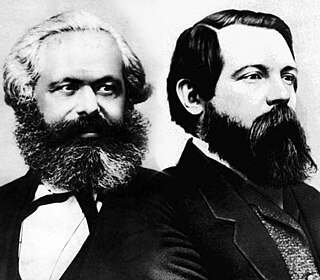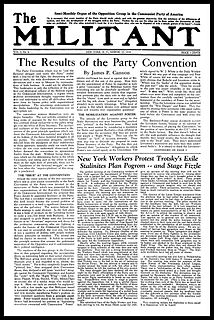Related Research Articles

The Fourth International (FI) is a revolutionary socialist international organization consisting of followers of Leon Trotsky, also known as Trotskyists, whose declared goal is the overthrowing of global capitalism and the establishment of world socialism via international revolution. The Fourth International was established in France in 1938, as Trotsky and his supporters, having been expelled from the Soviet Union, considered the Third International or Comintern as effectively puppets of Stalinism and thus incapable of leading the international working class to political power. Thus, Trotskyists founded their own competing Fourth International.

The Socialist Party of America (SPA) was a socialist political party in the United States formed in 1901 by a merger between the three-year-old Social Democratic Party of America and disaffected elements of the Socialist Labor Party of America which had split from the main organization in 1899.
Max Shachtman was an American Marxist theorist. He went from being an associate of Leon Trotsky to a social democrat and mentor of senior assistants to AFL-CIO President George Meany.

Jay Lovestone was an American activist. He was at various times a member of the Socialist Party of America, a leader of the Communist Party USA, leader of a small oppositionist party, an anti-Communist and Central Intelligence Agency (CIA) helper, and foreign policy advisor to the leadership of the AFL-CIO and various unions within it.

The Right Opposition or Right Tendency, in VKP(b) was a conditional label formulated by Stalin in fall of 1928 in regards the opposition against certain measures included within the first five-year plan by Nikolai Bukharin, Alexei Rykov, Mikhail Tomsky and their supporters within the Soviet Union that did not follow the so called "general line of the party". It is also the name given to "right-wing" critics within the Communist movement internationally, particularly those who coalesced in the International Communist Opposition, regardless of whether they identified with Bukharin and Rykov.

William Z. Foster was a radical American labor organizer and Communist politician, whose career included serving as General Secretary of the Communist Party USA from 1945 to 1957. He was previously a member of the Socialist Party of America and the Industrial Workers of the World, leading the drive to organize the packinghouse industry during World War I and the steel strike of 1919.

Bertram David "Bert" Wolfe was an American scholar and former communist best known for biographical studies of Vladimir Lenin, Joseph Stalin, Leon Trotsky, and Diego Rivera.
The International Revolutionary Marxist Centre was an international association of left-socialist parties. The member-parties rejected both mainstream social democracy and the Third International.

Benjamin "Ben" Gitlow was a prominent American socialist politician of the early 20th century and a founding member of the Communist Party USA. During the end of the 1930s, Gitlow turned to conservatism and wrote two sensational exposés of American Communism, books which were very influential during the McCarthy period. Gitlow remained a leading anti-communist up to the time of his death.

Albert Weisbord (1900–1977) was an American political activist and union organizer. He is best remembered, along his wife Vera Buch, as one of the primary union organizers of the seminal 1926 Passaic Textile Strike and as the founder of a small Trotskyist political organization of the 1930s called the Communist League of Struggle.

The Workers Party of America (WPA) was the name of the legal party organization used by the Communist Party USA from the last days of 1921 until the middle of 1929.

Herbert Moore "Harry" Wicks (1889–1956), best known as "Harry M. Wicks," was an American radical journalist and politician who was a founding member of the Communist Party of America. He was a plenipotentiary representative of the Communist International to Australia in 1930-31 and there directed the reorganization of the structure and leadership of the Communist Party of Australia.

The Lovestoneites, led by former General Secretary of the Communist Party USA (CPUSA) Jay Lovestone, were a small American oppositionist Communist movement of the 1930s. The organization emerged from a factional fight in the CPUSA in 1929 and unsuccessfully sought to reintegrate with that organization for several years.
The Fieldites were a small leftist sect that split from the Communist League of America in 1934 and known officially as the Organization Committee for a Revolutionary Workers Party and then the League for a Revolutionary Workers Party. The name comes from the name of its leader B. J. Field.

Charles S. "Sasha" Zimmerman (1896–1983) was an American socialist activist and trade union leader, who was an associate of Jay Lovestone. Zimmerman had a career spanning five decades as an official of the International Ladies Garment Workers Union. During the early 1970s, Zimmerman and Bayard Rustin were national Co-Chairmen the Socialist Party of America and the Social Democrats USA.
Benjamin Mandel (1887–1973) a.k.a. "Bert Miller" was a New York city school teacher and communist activist who later became an ex-communist director of research for the House Un-American Activities Committee (HUAC) and the Senate Internal Security Subcommittee (SIS).
Under a variety of names and within a number of organizations over at least 17 years, the group around Harry Turner, or Turnerites was a presence within Trotskyism in the United States.

The Communist League of America (Opposition) was founded by James P. Cannon, Max Shachtman and Martin Abern late in 1928 after their expulsion from the Communist Party USA for Trotskyism. The CLA(O) was the United States section of Leon Trotsky's International Left Opposition and initially positioned itself as not a rival party to the CPUSA but as a faction of it and the Comintern. The group was terminated in 1934 when it merged with the American Workers Party headed by A. J. Muste to establish the Workers Party of the United States.

James Patrick Cannon was an American Trotskyist and a leader of the Socialist Workers Party.
The Socialist Workers Party (SWP) is a communist party in the United States. Originally a group in the Communist Party USA that supported Leon Trotsky against Soviet leader Joseph Stalin, it places a priority on "solidarity work" to aid strikes and is strongly supportive of Cuba. The SWP publishes The Militant, a weekly newspaper that dates back to 1928. It also maintains Pathfinder Press.
References
- ↑ Workers Age Vol. 2 #3 Nov 15, 1932 p.6
- ↑ Workers Age Vol. 2 #4 Dec. 1, 1932 pp.4,7
- ↑ Workers Age Vol. 2 #4 Dec. 1, 1932 p.5
- ↑ Workers Age Vol. 2 #5 Dec. 15, 1932 p.4
- ↑ "Historically inevitable and correct..." Workers Age Vol. 2 #5 Dec. 15, 1932 p.5, Workers Age Vol. 2 #6 Jan. 1, 1933 p.4, and Workers Age Vol. 2 #7 Jan. 15, 1933 pp.5,7
- ↑ Workers Age Vol. 2 #7 Jan. 15, 1933 p.5 Workers Age Vol. 2 #8 Feb. 1, 1933 pp.4,7
- ↑ Workers Age Vol. 2 #9 Feb. 15, 1933 p.8
- ↑ "COMMUNISTS FORM FOURTH FACTION HERE :Extreme Right Group, Headed by Gitlow, Lays Russian Crisis to Stalin Policy.". New York Times. February 4, 1933. p. 6. ProQuest 99290798.
- ↑ Workers Age Vol. 2 #10 Mar. 1, 1933 p.6
- 1 2 3 Benjamin Gitlow I confess; the truth about American communism New York, E. P. Dutton 1939.
- ↑ Class Struggle Vol. 3 #6
- ↑ Class Struggle Vol. 3 #9
- 1 2 Max Shachtman "'New Group' for a 'New Party'" in The Militant Vol. VII #21 May 26, 1934 p.3
- ↑ The Militant Vol. VII #4 Jan 29, 1934 p.3
- ↑ "Expulsion of B.J. Field and A. Kaldis" in The Militant Vol. VII #11 March 17, 1934 p.2
- ↑ "No comment necessary" in Workers Age Vol. 3 #18 Oct 15, 1934 p.7
- ↑ "SOCIALISTS REBUFF REDS' OFFER TO JOIN :Party Closed to Communists in State, Waldman Retorts to Gitlow's Overture. LATTER EXPECTS WELCOME Leader of Schism Says Thomas Has Approved the Transfer -Hails 'Revolutionary Mood.'". New York Times. October 30, 1934. p. 10. ProQuest 118006324.
- ↑ ProQuest 101006450
- ↑ "SOCIALISTS TO BAR ALL COMMUNISTS :State Committee Repudiates Thomas on Admitting the Gitlow Faction. BUT HARMONY IS SOUGHT Leaders Here Vote to Confer on National Declaration -- Aim for Labor Party.". New York Times. November 12, 1934. p. 14. ProQuest 93433387.
- ↑ ProQuest 445668582
- ↑ LOUIS STARK (April 7, 1940). "SOCIALISTS ADOPT ISOLATION STAND TO BAR WAR ENTRY :Convention Accepts Majority View Opposing Economic Aid to Belligerents CAMPAIGN STARTS AT ONCE Leaders Refuse to Wait on Old Parties, Tied by Keynoter to Profit-System 'Failure' Decision to Open Campaign SOCIALISTS VOTE OPPOSITION TO WAR Keynoter Hits Profit System". New York Times. ProQuest 98351901.
- ↑ Goldwater, Walter Radical periodicals in America 1890–1950 New Haven, Yale University Library 1964 p.27